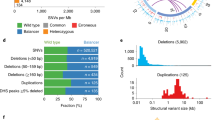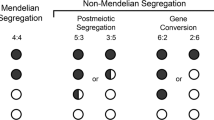Abstract
THERE has long been an interest in developing mouse stocks carrying chromosome inversions for mutation testing. This interest stems from the fact that heterozygosity for a paracentric inversion, that is, a structural rearrangement in which a chromosome segment that does not include the centromere is rotated through 180°, results in suppression of recombination in the inversion region. This is caused by the failure of recovery of the products of single crossovers in this region, because dicentric chromatids and acentric fragments are produced that either fail to give functional meiotic products or result in the formation of unbalanced zygotes which are generally eliminated. Recombination between the pair of chromosomes concerned is, therefore, confined to any crossovers in the non-inverted regions and to the rare two-strand double crossovers which may occur within the inversion region if it is a long one. This property of inversion heterozygotes enables the recovery, in the progeny, of the structurally normal homologue largely intact and any recessive mutation located on it can be readily detected if suitable genetically marked stocks are used. In the simplest case, when the mutation is a recessive lethal and the inversion is located in the X chromosome, detection is either by the absence of half the males, or if the inversion itself is marked by a recessive lethal (as in the C1B method devised by Muller for Drosophila melanogaster), by the absence of all the males.
This is a preview of subscription content, access via your institution
Access options
Subscribe to this journal
Receive 51 print issues and online access
$199.00 per year
only $3.90 per issue
Buy this article
- Purchase on Springer Link
- Instant access to full article PDF
Prices may be subject to local taxes which are calculated during checkout
Similar content being viewed by others
References
Roderick, T. H., Mutat. Res., 11, 59–69 (1971).
Phillips, R. J. S., Hawker, S. G., and Moseley, H. J., Genet. Res., Camb., 22, 91–99 (1973).
Russell, L. B., Science, 133, 1795–1803 (1961).
Phillips, R. J. S., and Kaufman, M. H., Genet. Res., Camb., 24, 27–41 (1974).
Phillips, R. J. S., Mouse News Letter, 52, 35 (1975).
Mouse News Letter, 51, 2 (1974).
Gallimore, P. H., and Richardson, C. R., Chromosoma, Berl., 41, 259–263 (1973).
Nesbitt, M. N., and Francke, U., Chromosoma, Bert., 41, 145–158 (1973).
Dev, V. G., Grewal, M. S., Miller, D. A., Kouri, R. E., Hutton, J. J., and Miller, O. J., Cytogenetics, 10, 436–451 (1971).
Searle, A. G., Adv. Radiat. Biol., 4, 131–207 (1974).
Author information
Authors and Affiliations
Rights and permissions
About this article
Cite this article
EVANS, E., PHILLIPS, R. Inversion heterozygosity and the origin of XO daughters of Bpa/+ female mice. Nature 256, 40–41 (1975). https://doi.org/10.1038/256040a0
Received:
Accepted:
Issue Date:
DOI: https://doi.org/10.1038/256040a0
This article is cited by
-
Identification of a cluster of X-linked imprinted genes in mice
Nature Genetics (2005)
-
Xlr3b is a new imprinted candidate for X-linked parent-of-origin effects on cognitive function in mice
Nature Genetics (2005)
-
The meiotic checkpoint monitoring sypapsis eliminates spermatocytes via p53-independent apoptosis
Nature Genetics (1998)
-
Nonhomologous synapsis of the XY during early pachynema in In(X)1H male mice
Genetica (1987)
-
Further examination of the production-line hypothesis in mouse foetal oocytes
Chromosoma (1986)
Comments
By submitting a comment you agree to abide by our Terms and Community Guidelines. If you find something abusive or that does not comply with our terms or guidelines please flag it as inappropriate.



